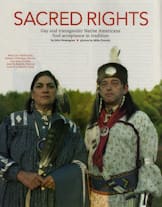
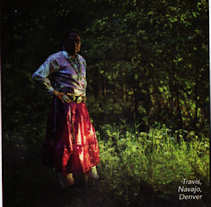
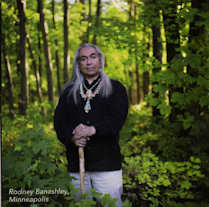
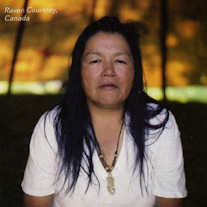
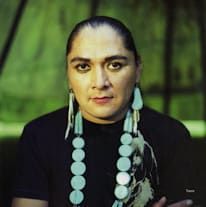
He checks his plaid skirt, stockings, and deep-cut white blouse. When another man’s eyes fall on his cleavage, Richard squeezes his breasts together and answers the silent inquiry: “They’re real!”
Beyond the bathroom doors, men and women dance around a drum in more traditional costume—feathers, fox pelts, moccasins, beads, and bells. They’re all here for the 20th annual International Two Spirit Gathering, a celebration of and for those who feel they carry both male and female spirits.
In late August 2008, some 85 Native lesbian, gay, bisexual, and transgender (LGBT) people from three dozen tribes in Canada and the United States traveled to the Audubon Center of the North Woods, 90 miles north of Minneapolis.
There, communing under the tall pines, they would sit in a sweat lodge, pray together at the sacred fire, engage in a water ceremony, and dance at the powwow. They would listen to a mother talk about her son’s struggle with coming out, hear the results of a groundbreaking health study, and receive a blessing from an elder.
They would also watch Sanchez—in full drag, lip-synching his version of “I Kissed a Girl”—win the event’s annual talent contest.
“We want people who face difficulties in their day-to-day lives to be able to stop and breathe,” says Richard LaFortune, a Yupik from Minneapolis and national director of Two Spirit Press Room, sponsor of the 2008 event. “We want people to walk away with new friendships, good memories, and something to restore themselves.”
Organizers have wanted to keep out spiritual and cultural tourists who may be well intentioned but nosy. In 2008, however, they decided to allow a few media representatives, including an Utne Reader writer and photographer, to attend in order to tell their stories to a wider audience.
The Minneapolis Native community hosted the first Two Spirit Gathering in 1988. “We didn’t have a lot of places to meet and socialize except with the mainstream LGBT community, which was in bars, and those aren’t a good place for us,” says LaFortune, one of the event’s original organizers. Since then, some 3,200 people have attended the alcohol- and drug-free gathering in locales including Montreal, Vancouver, Kansas City, Eugene, Tucson, San Jose, and Butte.
Many in the Two Spirit community just don’t feel at home within the broader LGBT scene. Karina Walters, a Two Spirit Choctaw and a professor of social work at the University of Washington, tells the group gathered at the Audubon Center about “the feeling of being expected to go along with the white homosexual party line, like getting your first dyke haircut or going to a gay bar and having a certain type of experience.”
Many are also misunderstood and shunned within their Native communities, even though some tribes once honored those with male and female spirits as shamans, warriors, and chiefs.
Men and women at the gathering speak of parents avoiding them or kicking them out of their homes, even being beaten by neighbors. “That’s what really hurts us, when our own people throw us out,” says L. Frank Manriquez, a Tongva-Ajachmem woman from Southern California. Manriquez, now 56, left as a teenager after her uncle asked if she was going to seduce her sister. “I about threw up,” says Manriquez. “In his eyes, I wasn’t human.”
Misunderstanding and fear can manifest themselves—as they do in mainstream society—in overt abuse. Targeted because of both their race and their orientation, members of the Two Spirit community suffer higher incidences of physical and sexual abuse than the general population. According to a study Walters just conducted with funds from the National Institutes of Health, gay Native Americans also have higher rates of addiction, homelessness, depression, and suicide.
More often, though, LGBT Native Americans suffer a daily battering of “microagressions.” Walters defines these as “chronic injustices, messages that people of color endure every day that are denigrating, demeaning, and subtle.”
Take Richard Sanchez. Today, the 45-year-old theater prop artist from San Jose has an ebullient personality, but he has not always carried himself so confidently. When he was growing up in rural Northern California, the boys in his family adhered to rigid gender roles, fixing cars and taking care of livestock. Making clothes and cooking were not options, being gay out of the question.
It was not even cool to be Native American. Raised by his grandparents and schooled in the Catholic faith, Sanchez was taught that his ancestors were Mexican. It was not until he was 16 years old that his grandmother, literally on her deathbed, revealed the family’s Navajo heritage.
By then, his sexual identity was clear. As a preschooler, Sanchez was walking to school with his brother when they stumbled upon a girlie magazine. The pictures of naked women mesmerized his older brother, but Sanchez stared at the half-naked men. By the time he was 10, he had defined himself as gay and knew that meant he would be ridiculed. “My favorite character was Pinocchio, because he wanted to be a real boy,” Sanchez says. “I wasn’t a real boy because I was a sissy.”
During a break in the schedule, two men toss a football on the lawn in front of five colorful tepees. Two women, seated on the hillside above the lake, discuss a beading project. Half a dozen men and women smoke cigarettes outside the dining hall and trade jokes. “The laughter helps heal and transform all that oppression sickness that we get from this culture,” says Lawrence Ellis, a 47-year-old who refers to himself as Native, American, and African American. “There’s just such joy.”
A letter from Barack Obama to the Two Spirit Gathering pledges to “bring about a more tolerant America.” Clyde Bellecourt, a 72-year-old elder and one of the founders of the American Indian Movement, speaks to the group about the importance of connecting with their identity. His words carry special weight and move some to tears: “I stand in total solidarity with each and every one of you,” he tells them. “I love you.”
Bellecourt’s blessing, Obama’s words, and the gathering itself honor the community. “It’s a way to keep something sacred and alive,” Manriquez says. “Some people here are doing remarkable things, even if it’s as simple as being themselves.”
© John Rosengren
